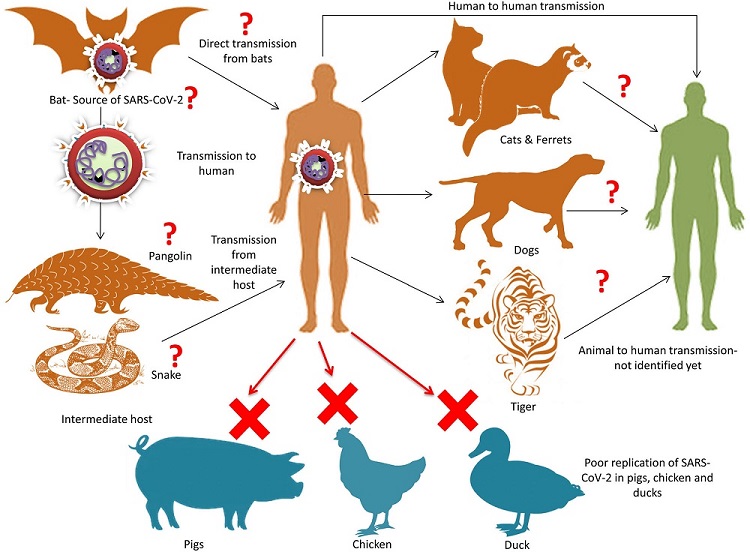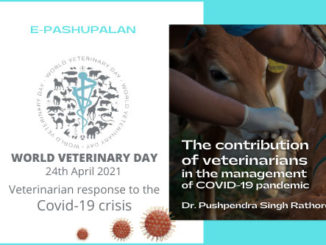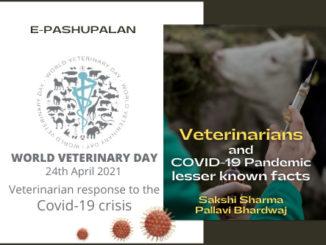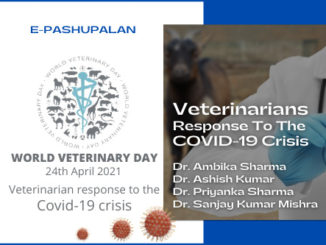Abstract
COVID-19 disease emerged from seafood and animal market in Wuhan, Hubei Province, China in late 2019. On 30 January, World Health Organisation (WHO) declared as a public health emergency of international concern and waited until 11 march to announced it as a pandemic (Hua and Shaw, 2020). The COVID-19 has adversely affected the global economy, especially in developing nations. This outbreak not only disrupted the multinational businesses, global market trading, tourism, transportation, export-import, but also reduced the income generated from the market (Ayittey et al. 2020). This pandemic may be transmitted from animal- human and human to animal (reverse zoonosis). The risk of reverse zoonosis increased, where human come close contact with pet and zoo animals. Veterinary services contributed in various ways towards building a common response to the pandemic like surveillance and monitoring of wildlife, vaccine development, assessment of import animal etc. During the period of COVID-19 crises, it should not be forgotten that veterinarian services to addressing critical needs, food security and safety and their multiple activities in various field.
Keywords: COVID-19; Zoonosis; Virus; Veterinarian; Human.
Introduction
Severe acute respiratory syndrome coronavirus2 (SARS-CoV-2), termed corona virus infection disease 19 which emerged from seafood and animal market in Wuhan, Hubei Province, China in late 2019. The infection of COVID-19, firstly localized to Wuhan city of China, within short period of time it spread to neighbouring provinces. On 30 January, World Health Organisation (WHO) declared as a public health emergency of international concern and waited until 11 march to announced it as a pandemic.(Hua and Shaw,2020). SARS-CoV-2 belongs to the Coronaviridae family of order Nidovirales. The members of Nidovirales (from the Latin nidus, “nest”) use a distinctive “nested set” transcription strategy in which the expression of the genes that code for viral proteins are “nested” as sub-genomic sequences.(Stern and kennedy,1980) The coronavirus genome consisting of positive-sense, single-stranded, poly-adenylated, non-segmented RNA (Leroya, et al., 2020). In the beginning of 21st century, other corona virus can caused illness ranging from common cold to more severe disease such as MERS-CoV and SARS-CoV in 2002 and 2012, respectively but the current SARS-CoV-2 pandemic affected huge population accounting a total number of nearly 121 million confirmed cases along with death toll of nearly 2.6 million by march 17, 2020 (WHO 2021). Detailed investigation had reported that MERS-CoV was transmitted from dromedary camels to human and SARS-CoV-2 from civet to human. The COVID-19 has adversely affected the global economy, especially in developing nations. This outbreak not only disrupted the multinational businesses, global market trading, tourism, transportation, export-import, but also reduced the income generated from the market (Ayittey et al. 2020). In spite of enormous research efforts around the world, there are still many uncertainties like identity of the original animal source of SARS-CoV-2, intermediate animal host, route of virus transmission to human, virus mutation and their impact on pathogenicity and vaccine and vaccination strategies. Pandemic is the result of fast and effective spread of the virus between human being in an large immunologically weak population. It has been reported that animals are involved in the genesis of COVID-19 and possibly in the maintenance of COVID-19 in the human population. The findings of COVID-19 in case of respiratory disease and sudden death in mink in the Netherland, Denmark identifies the same genetic characteristic as affected mink have been isolated from in contact farm workers which effected COVISD-19 infection (Ferri and Evans 2021). This shows the zoonotic capabilities of this virus means direction of transmission is bidirectional animal to human and human to animal. Therefore veterinary and human medical professions come together for effective management of COVID-19 and future pandemics caused by animal origin pathogens by developing strategies and methodological integration.
Veterinary Profession, Zoonosis Relationship, And Transmission
The most of the emerging diseases (eg. Ebola, Zika, Nipah encephalitis) and all known pandemics (eg. influenza, SARS, MERS, HIV/AIDS) are zoonoses, predominantly originating from wildlife (Daszak, et al., 2020). Coronavirus looks to be crossed the species barrier third time after the SARS and MARS in the past. Among the coronavirus infections, recent zoonotic sach as SARS-CoV-2, MARS-CoV and SARS-CoV have greater importance due to their severity of disease in humans and their higher spreading capability (Rothan and Byrareddy 2020). Due to the mutation in the RBD region of S gene of CoVs, the host range get expanded to infect other host species of animals or humans, pathogenicity and transmissibility of virus may further get altered and increased, becoming a matter of global worry (Chen 2020; Patel and Jernigan 2020). On the basis of findings, several animal species that have been reported to be susceptible to SARS-CoV-2 infection through naturally (cats, dogs, minks, lions, tigers), infected humans and after experimental infection (mice, cats, ferrets, hamsters, primates, tree shrew) (Leroya, et al., 2020). This pandemic may be transmitted from animal- human and human to animal (reverse zoonosis). The risk of reverse zoonosis increased, where human come close contact with pet and zoo animals. Free ranging bats which is immunologically weak susceptible to infection of COVID-2 and also play role to spread COVID-19 from human to wild animals (Massenger, et al., 2014). Some cases have been reported that COVID-19 infection transmitted from human to their pet animals like a dog (Pomeranian) belonging to a 60 year old women who infected COVID-19 symptoms on February 12, 2020 and a German shepherd dog in Hong-Kong become ill with COVID-19 symptoms. A pet cat who become infected with SARS CoV-2 symptoms from its owner Italy and another cat infected with COVID-19 symptoms case has been reported in Hong- Kong. While, some cases have been reported in wild animal like tigers, mink and other wild animals. A four year old tiger, Nadia reported test positive for SARS-CoV-2. (James, 2020).Several species have been tested for susceptibility to the virus through experimented infection and natural setting when come in contact with infected humans. Infected animals can transmit virus through contact sach as mink to mink, mink to cat etc. there is also evidence from experimental infection studies that poultry and cattle are not susceptible for the infection. It was initially assumed that SARS-CoV-2 transmitted from animals to humans followed by transmitted from human to human. (Hui, et al., 2020). Origin of the COVID-19 still under investigations, but 96% genomic sequence of COVID- 19 virus and coronavirus of china bat (Rhinolophus affinis) is similar. This shows that COVID-19 virus remain in bats since decades. However, we can say it is not a laboratory constructed or a purposively manipulated virus. (olival, at el., 2020)

Role Of Veterinarian During The Covid-19 Pandemic
The pandemic like SARS, MERS and SARS-CoV-2 indicate that health of animal ,human and environmental is completely linked with each other and raise the need for a transdisciplinary approach that is One Health Approach. But the question is that how can veterinarian actively interface with medical sector to deal with COVID-19 pandemic. Coronavirus is well known to veterinary virologist since decades. Coronavirus is the member of the subfamily Orthocoronavirinae in the family Coronaviridae and the order Nidovirales. Veterinarians play important role to surveillance and control the outbreaks pandemic including zoonosis disease. Veterinary services contributed in various ways towards building a common response to the pandemic. Veterinarians are involved in the discovery of medicine and immunological compounds. Various veterinary institutes in the USA and Australia are doing different research related with COVID-19 (Pedersen et al., 2019).Veterinary laboratories used their experience and expertise to surveillance, screening and testing human samples. Some veterinary clinics have been providing essential materials such as personal protective equipment and ventilators. Veterinarians also provided their service in hospitals and laboratories where human resources are not sufficient. In some countries veterinary epidemiologist provided their service to truck the disease in human and to support the development of effective public health interventions (Anonymous, 2021). There are different field in which veterinarian play important role as follow:
1. Surveillance and Monitoring of Wildlife for Pandemic Viruses:
Majority of infectious pathogens in human are zoonosis in origin. Man-made activities like intense agriculture, environment destruction, land clearing, deforestation, climate change and wildlife trade is putting humans close contact with animals carrying microbes. (Ferri and Evans, 2020). About 1.7 million viruses are undiscovered currently that exit in mammalian and avian, about eight lakh viruses have the ability to spill entire animal- man populations Among the targeted species, Bats are ideal reservoir and bearing known dangerous viruses like malaria, Zika, Ebola, and Nipah. (Han, et al.,2019). To explore and prevent future pandemics, it is important to understand their origin, evolution and geographical distribution in reservoir host. Veterinary virologists play important role in study of virus evolution, find out the pathogenesis of viruses in wild and domestic animals. So, integrated surveillance studies are essential to explore the aetiology of viral zoonosis and their impact on the human, animal and ecosystem.
2. Contributions Of Veterinarian In Vaccine Development:
The progress in the genome sequencing technique and bioinformatics analysis, a strong action has been taken against COVID-19. Many efforts have been directed to develop vaccine against human corona virus infection. In this case of corona virus infection, development of suitable animal modal that mimcs the clinical disease can inform on the pathogenesis as well as help in developing vaccine and therapeutics against COVID-19. Various animal research has been contributed in developing of vaccine against human infections like polio, measles, meningitis, tuberculosis and human papillomavirus that saved millions of human life. (Stanley, et al., 2014) In the presents scenario to develop human COVID-19 vaccines, various veterinarian and veterinary universities are carrying out different research related to SARSCoV-2 like coronavirus testing, development of sample diagnostic kits for SARSCoV-2 and working for the development of COVID-19 vaccine in Louisiana State University, School of Veterinary Medicine. (Gautam, et al., 2020). An integrated and interdisciplinary research collaboration, could help in batter understanding of the origin and spread of SARS-CoV-2 and drive future research in human medicine toward the development of vaccine and effective antiviral drugs.
3. veterinarian work as toolbox in public health sector
Veterinarians operate in the veterinary public health system in which human health is the central task. Veterinarians have lots of field experience in the control of various past epidemic like bluetongue, foot and mouth disease, brucellosis, tuberculosis etc. used in the variety of surveillance methods to understand the way of spread virus agent, and to support evidence based, sustainable and timely measures for the reduction of the level of prevalence and elimination of infectious diseases in animal population. (Hoinville, et al., 2013). Many applications and links from the web are run by the veterinarian to analysis sample sizes and real prevalence of epidemics disease. The strategy of prevention and control of transmissible animal diseases including zoonoses is a core task of the veterinary services of each OIE member country. Using active and passive surveillance system and risk analysis, veterinarian might provide a valuable contribution of knowledge to public health for infection in human being. Real time active random surveillance, a basic veterinary protocol has been proposed for coronavirus infection (Foddai, et al., 2020). In the case of coronavirus outbreak, use of repeated representative random sampling of the human population at the local and regional level is helpful (Ferri and Evans, 2020). Collaboration between veterinarian epidemiologists and public health representatives is helpful in controlling COVID-2 outbreak and combinedly work as toolbox.
4. Diagnosis, Molecular Analysis and Assessment of Import Animal during COVID -19 crises
COVID -19 pandemic has been severely affected health care system of human being worldly. Its effects mainly those countries which was not prepared to slow down the spread of the virus because of heavy work load of medical laboratories, lack of equipment and other facilities. At that time, veterinary sector play important role as many veterinarian laboratories in many country carried out SARSCoV-2 testing of human samples, provides protective materials, ventilators etc. Veterinarian having wide knowledge in animal import risk assessment can support government in planning a COVID-2 risk strategy for international air travel. Animal import risk assessment policy can be adopted against COVID-19 for countries to assess the impact of any changes in disease occurrence. Such type of policy developed by U.K. public health England modelling team and providing scientific advice to government on travel controls during coronavirus infections (Taylor, et al., 2020).
Conclusions
Live animal markets like seafood market Huanan, China will act as point where domestic and wild animals contact with each other and inter-species transmission of coronavirus infection increased. So permanent ban on the wild animal market should be implemented which help in controlling zoonotic disease like SARSCoV-2 in the future. Local and international regulatory authorities need to develop and implemented strong disease control mechanism that effectively decrease possibility of human exposure to wild animal. COVID-19 outbreak that proves existence of a close interaction between humans, animals and environmental health that result in emergence of deadly pandemic (Ferri and Evans, 2020). Therefore most effective way to prevent zoonosis outbreak is to maintain barrier between natural reservoirs and human society. In reference of COVID-19 pandemic, veterinarian paly important role in various dimensions. Veterinarian operate in veterinarian public health system, act as veterinarian virologists, coordinate virus surveillance, pathogenesis studies in wild and domestic animals etc. During the period of COVID-19 crises, it should not be forgotten that veterinarian services to addressing critical needs, food security and safety and their multiple activities in various field. In future, veterinarian is warranted by the current problems of society (Lorussol, et al., 2020). This can be achieved by a revolution change in veterinarian schools teaching programs. Epidemiology, ecology, social sciences and communication are the fundamental tools for the future veterinarians that will face future pandemic of animal origin.
References
- Anonymous (2021). Questions and Answers on COVID-19, world organisation for animal health.
- Ayittey, F.K., Ayittey, M.K., Chiwero, N.B., Kamasah, J.S. and Dzuvour, C. (2020). Economic impacts of wuhan 2019-nCoV on China and the world. Journal of medicine virology, 92(5):473–475.
- Chen J. (2020). Pathogenicity and transmissibility of 2019-nCoV-A quick overview and comparison with other emerging viruses. Journal of Microbes Infection, 22(2):69–71.
- Daszak, P., Amuasi, J., Naves, D., Hayman, D., Kuiken, T., Roche, B., Zambrana, T., Buss, P., Dundarova, H., Feferholtz, Y., Foldy, G., Igbinosa, E., Wannous, C., Woolaston, K., Mosig, P., Pascual, U., Stocett, P. and Li, H. (2020). Biodiversity and Pandemics of the Intergovernmental Platform on Biodiversity and Ecosystem Services . workshop report,
- Foddai, A., Lubroth, J. and Iversen, E (2020). Base protocol for real time active random surveillance of coronavirus disease (COVID-19) – Adapting veterinary methodology to public health. One health Elsevier, 2815-3229.
- Gautam, A., Khanal, A., Subedi, D., Bhandari, S. and Kaphle, K. (2020). Contribution of Veterinary Sector to Control COVID-19 Pandemic in Nepal, world veterinary journal, 10(3):297-305.
- Han, M., Anderson, D.E. and Zhang, Q. (2019) Dampened NLRP3-mediated inflammation in bats and implications for a special viral reservoir host. Nature microbiology, 4: 789-799.
- Hoinville, L.J., Alban, L., Drewe, J.A., Gibbens, J.C., Gustafson, L., Hasler,B., Saegerman,C., Saman,M. and Stark, K. (2013). Proposed terms and concepts for describing and evaluating animal health surveillance systems. Preventive veterinary medicine, Elsevier, 112(1-2) :11-12.
- Hue, J. and Shaw, R.(2020). Corona virus (Covid-19) “infodemic” and emerging issues through a data lens: The case of china. International journal of environmental research and public health,17(7).
- Hui, D.S., Azhar, E., Madani, T.A., Ntoumi, F., Kock, R., Dar, O., Ippolito, G., Mchugh, T.D., Memish, Z.A. and Drosten, C.(2020). The continuing 2019-nCoV epidemic threat of novel coronaviruses to global health – The latest 2019 novel coronavirus outbreak in Wuhan, China. International journal of infection disease, 91:264-266.
- Leroya, E., Meriadeg, A.G. and Picoux, J.B. (2020). The risk of SARS-CoV-2 transmission to pets and other wild and domestic animals strongly mandates a one-health strategy to control the COVID-19 pandemic. Elsevier, 2352-7714.
- Lorussol, A., Calistrial, P., Petrinil,A., Savinil, G. and Decaro, N.(2020). Novel coronavirus (SARS‑CoV‑2) epidemic: a veterinary perspective. Veterinaria Italiana, 2-4.
- Massenger, A.M., Barnes,A.N. and Gray, D.C. (2014). Reverse zoonotic disease transmission (zooanthroponosis): a systematic review of seldom-documented human biological threats to animals. Journal of PLos One, 9 (2).
- Olival, K.J., Cryan, B.R., Amman, B.R., Barik, R.s., Blehert, C.E. and Brook (2020). Possibility for reverse zoonotic transmission of SARS-CoV-2 to free-ranging wildlife: a case study of bats. Journal of PLos pathogens, 16(9).
- Pedersen, N., Perron, M., Bannasch, M., Montgomery, E., Murakami, E., Lienieks,M. and Liu, H. (2019). Efficacy and safety of the nucleoside analog GS-441524 for treatment of cats with naturally occurring feline infectious peritonitis. Journal of feline medicine and surgery, 21(4): 271-281.
- Rothan, H.A. and Byrareddy, S.N. (2020). The epidemiology and pathogenesis of coronavirus disease (COVID-19) outbreak. Journal of autoimmunity,109.
- Stanley, D.A., Honko, A.N., Asiedu, C., Trefry, J.C., Lau-kilby., Johnson, J.C., Hensley,L., Ammendola, V., Abbate, A., Grazioli, F., Foulds, K.E., Cheng, C., Wang, L., Donaldson, M.M., Colloca, A., Folgori, M., roederer, G.J., Nabel, J., Mascola, A., Nicosia, R., Cortese, R.A. and Sullivan, N. (2014) Chimpanzee adenovirus vaccine generates acute and durable protective immunity against ebolavirus challenge. Journal of natural medicine, 20(10): 1126-1129.
- Taylor, R., McCarthy, C.A., Patel, V., Moir, R., Kelly,L and Snary,E. (2020). The risk of introducing SARS-CoV-2 to the UK via international travel in August 2020. medRxiv preprint









Be the first to comment